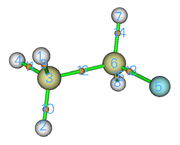Multiwfn forum
Multiwfn official website: http://sobereva.com/multiwfn. Multiwfn forum in Chinese: http://bbs.keinsci.com/wfn
You are not logged in.
- Topics: Active | Unanswered
#1 2022-02-19 06:43:44
Performing AIM topology analysis based on electron density grid data
Usually, AIM topology analysis in Multiwfn is performed based on wavefunction file (as exemplified in Section 4.2.1 of Multiwfn manual), and this is the best choice. However, this analysis may also be performed based on grid data of electron density (though it is rarely used), as will be illustrated in this post. The electron density can be recorded in any grid data format that recognizable in Multiwfn, such as .cub, .vti, .dx, .grd, see Section 2.5 of Multiwfn manual for detail. The data may come from theoretical calculation or experimental crystal diffraction. In this example, the electron density grid data simply comes from a wavefunction file of C2H5F molecule. Please make sure that you are using latest version of Multiwfn.
Boot up Multiwfn and input
examples\C2H5F.wfn
5 // Calculate grid data
1 // Electron density
3 // High quality grid (relative to small system)
2 // Export grid data as cube file
Now you have density.cub in current folder.
Open settings.ini, set "iuserfunc" to -3. Then the user-defined function will correspond to B-spline interpolation function based on the loaded grid data.
Boot up Multiwfn and input
density.cub
2 // Topology analysis
-11 // Delete results and reselect real space function
100 // User-defined function
2 // Search CPs from nuclear positions
3 // Search CPs from midpoint of atomic pairs
From the result on screen and the map shown by option 0, you can see that the nuclear and bond critical points have been successfully located.
Note that AIM topology analysis requires gradient and Hessian of electron density. In this example, they are obtained based on finite difference of the electron density yielded by B-spline interpolation based on the loaded electron density grid data. Since both numerical derivatives and interpolation are accompanied by more or less numerical error/noise, for some systems, you may encounter convergence problem during searching critical points, at that time you may consider using corresponding options in "-1 Set CP searching parameters" to slightly loosen convergence criteria. Also, use finer grid data (smaller grid spacing) may be helpful.
Via analogous way, you can utilize Multiwfn to perform topology analysis for any real space function based on its grid data. However, bear in mind that if the function has a complex distribution behavior, sometimes search of critical points may be unsuccessfully, due to the aforementioned reasons.
After locating critical points, only value of user-defined function can be directly read from option 7 for the critical points. If you also need to evaluate other properties, such as electron energy density, you should reboot Multiwfn and load grid data file of corresponding real space function, then enter main function 1, and manually input the position of the critical points you previously obtained, then read user-defined function value (again, corresponding to the interpolated value based on the present grid data).
Offline
#2 2022-03-05 13:44:44
- ridstk
- Member
- Registered: 2022-03-03
- Posts: 3
Re: Performing AIM topology analysis based on electron density grid data
Hi,
I followed the same steps to find out the critical points between atomic pairs but it showed no critical points in the output. It does not satisfy the PH relationship. What should I do next?
Offline
#3 2022-03-05 14:01:17
Re: Performing AIM topology analysis based on electron density grid data
Hi,
I followed the same steps to find out the critical points between atomic pairs but it showed no critical points in the output. It does not satisfy the PH relationship. What should I do next?
What input file did you use?
In addition, if possible, please upload your screenshot so that I can visually examine if a critical point should occur between the atomic pairs according to my experience.
Offline
